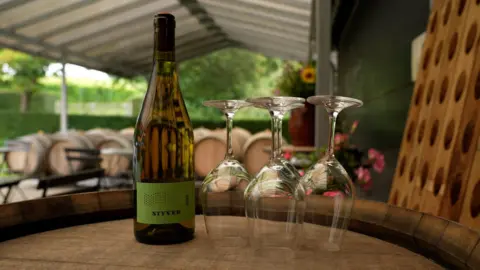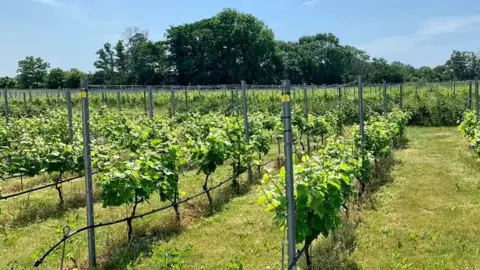[ad_1]
 PJ
PJSipping a glass of native wine is probably going not what springs to thoughts when visiting Scandinavia, however this colder, northerly area is rising as a brand new wine frontier.
Tons of of business vineyards are actually dotted throughout Denmark, Sweden, and even Norway, as a primary era {of professional} winemakers remodel what was as soon as a distinct segment passion right into a small however flourishing business.
Far north of France’s Bordeaux or California’s Napa Valley, greater than 10,000 vines develop on a hillside on Zealand, Denmark’s greatest island.
“Individuals have discovered that it’s truly attainable to develop wine in Denmark, so newcomers are coming, yr after yr,” says Nina Fink, as she reveals the PJ her three-hectare (seven-acre) vineyard, Vejrhøj Vingård.
Nina and her husband Niels began their operation 13 years in the past, after retiring from enterprise jobs in Copenhagen. They develop predominantly inexperienced grapes, producing floral white wines, in addition to glowing and rosé.
“We have now longer summer time days with extra daylight than you could have in France or in Italy, so the circumstances are totally different,” she explains.
For many Scandinavian vineyards, solaris is the grape of alternative – an fragrant, hybrid selection that is well-adapted to colder climes, ripens simply, and is extra illness resistant, permitting vineyards to keep away from spraying pesticides.
The grape was first bred in Germany in 1975, however solely adopted in Scandinavia from 2004, after which winemaking took off.
Niels Fink says that persons are positively shocked once they style the wines from Vejrhøj Vingård. “There’s a bit twinkle of their eye, then comes this half smile,” he chuckles. “Individuals prefer it.”
The Finks promote their bottles direct from the vineyard, however in addition they provide a few of Copenhagen’s prime eating places, together with the three Michelin star Geranium.
Initially they made simply 4,000 bottles yearly, however now they promote 20,000. “We’re restricted by the provision we’re capable of provide,” says Mr Fink.

Business vineyards in Denmark and Sweden have solely been allowed below European Union guidelines since 2000. Winemaking picked up round 2010, seeing a shift from newbie growers to extra formidable manufacturing.
Curiosity, and the very fact “it is attainable”, has attracted wine entrepreneurs, explains Jean Becker, from the Danish Wine Affiliation.
“I used to be one of many ones that began within the yr 2000. We had been six growers,” says Mr Becker, standing in his winery 25km (15 miles) north of Copenhagen.
There are actually 150 industrial wineries in Denmark with a mixed 125 hectares of vines, plus greater than 1,000 passion growers.
In the meantime, Sweden has 47 industrial operators spanning 193 hectares, in response to the Swedish Wine Affiliation, and the largest has 125,000 vines.
“I started with 500 vines,” stated Jean Becker, “In the present day, new winegrowers are beginning with 15,000-25,000. They begin larger in scale. Is there a marketplace for it? The reply is sure.”
But it surely’s an business nonetheless in its infancy, in comparison with the 800,000 hectares cultivated in France, and nearly 1,000,000 hectares in Spain.
In southern Zealand, Jesper Rye Jensen, who runs Vesterhave Vingaard, produces crimson wines from varieties like pinot noir and merlot, often related to France.
“It is rather difficult as a result of it is new for us,” he says. “We have now to study it. It is not like southern Europe, the place they’d era after era.”
Knowledge reveals that each Denmark and Sweden have seen common temperatures rise nearly two degrees celsius over the previous 40-50 years, leading to milder winters and a longer fruit-growing season. However there stays a danger of frost injury.
Jesper Rye Jensen says that as a northerly wine producer local weather change works in his favour. “We wine growers in Denmark are pleased that we’re getting a bit bit higher climate.”
However Niels Fink reckons that the warming local weather is a double-edged sword. “Local weather change is accompanied by all types of evils, equivalent to extra excessive climate phenomena, lengthy drought, heavy rain. That’s as threatening right here as it’s elsewhere.”
 Thora Vineyard
Thora VineyardNevertheless, Prof Torben Bo Toldam-Andersen, a fruit science researcher from the College of Copenhagen, says that somewhat than an extended rising season, it’s the emergence of latest, hardier grapes that largely kick-started the rise of Scandinavian wineries. “Local weather change makes it simpler for certain, however the primary driver is the brand new cultivars.”
He’s main a programme referred to as “FastGrapes”, which exams forms of vines, to search out essentially the most strong and finest suited to northern Europe.
They’re chosen in response to how shortly their grapes ripen, and their resilience to pests, illness, and different environmental stresses. New seedlings can then be grown on a better scale.
“There are such a lot of issues that go into the right wine,” says the researcher. “A part of that search occurs within the lab… you’ll be able to see the genes that make it sturdy.”
The primary chosen vines are actually rising in 15 check places, throughout Scandinavia, Lithuania, northern Germany and Belgium.
However even with the absolute best grape varieties and hotter climate, Scandinavian wineries face quite a few challenges, equivalent to excessive labour prices and strict guidelines on using chemical remedies to sort out any illness within the vineyards.
Romain Chichery says it may also be troublesome for wineries to search out employees. Born and raised in France, he moved to Sweden shortly after finishing his research in winemaking and viticulture.
Now 27, the winemaker works at Thora Winery on the nation’s southwestern Bjäre peninsula. “We have to practice employees, or we’ve to convey them from exterior [the country],” he says.
However ”ranging from scratch” in Sweden, he provides that he enjoys the liberty to experiment. “It is not simply copy paste, which has been accomplished for many years, or centuries, within the older viticulture world.”
Thora’s proprietor, American expat Heather Öberg says all the trouble and expense is price it. “We are able to compete with different European wines,” she says.
But, home-grown Scandinavian wine presently makes up only a fraction of the buyer market, and bottles are costly. Danish wine in Denmark prices from 200 kroner ($27; £22) a bottle upwards, greater than twice the value of the most cost effective French and Spain imports. Solely a negligible quantity is exported.
“We’ll by no means get in competitors with France, Italy and Spain as a result of they’ve very low costs,” says Mr Becker.
At his central Copenhagen wine store, Vino Fino, proprietor Nicolai Christiansen principally sells French wine. But he says he has lately bought a case of Danish wine to a bar proprietor in France.
“Should you can promote it to a French man, you’ll be able to most likely promote it to all people,” he jokes.
Nevertheless, he’s nonetheless to be satisfied about Danish wine. “The Danish wine continues to be too costly,” he says. “It is arising. however I nonetheless suppose there’s some approach to go earlier than the standard is there.”

[ad_2]
[ad_1]
#chilly #Scandi #wines #hope #win #drinkers
[ad_2]
, 2024-12-16 00:01:00




